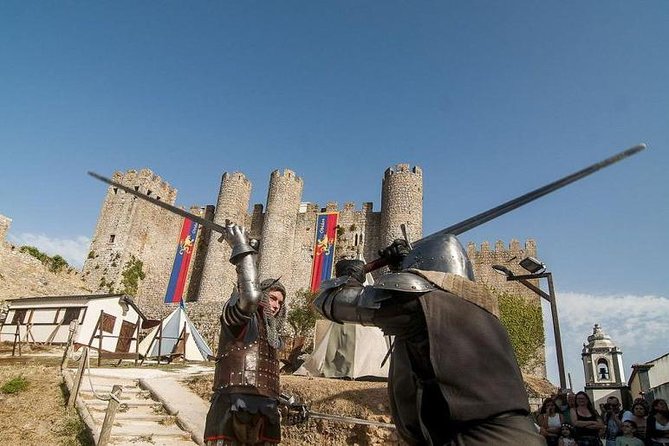
Private Tour: Discover the Rich Medieval History of Obidos
Enjoy visits Obidos the capital of romanticism, affords a rewarding 8 hours Private Tour experience. Obidos is, is one of the most picturesque and beautiful villages of Portugal. The monuments have a grand architecture full of stories and unraveling mysteries. Óbidos or "fortified city" had its origin in an early Roman settlement near the foothills of an elevated escarpment. Óbidos is the most beautiful medieval town that was part of the dowry of Portuguese queens and integrated the fortresses built by the Templars. Discover the Óbidos harmony of the architectural designs of the houses and churches. Take a walk around the historical walls and feel their texture and taste the liquor "Ginjinha". Your Private tour also includes a free and flexible pick-up (9am)/drop-off (5pm) from your located accommodations, driver/guide
Options
Private Tour: Discover the Rich Medieval History of Obidos
Pickup included
What's included in Private Tour: Discover the Rich Medieval History of Obidos
(Subject to Option Inclusions)Itinerary
Obidos VillagePass-by Only
You will visit Obidos is the finest example of a Portuguese walled town, and is one of the best tourist destinations of the Lisbon region. Historically, Obidos was presented to the Queen of Portugal on her wedding day, a tradition that began with Queen Urraca in 1214 and continued until the 19th century. This royal patronage has left an enduring legacy of pride within the town, and today it is one of the most characterful towns of central Portugal. You will explore Obidos; there are narrow-cobbled streets, traditional painted houses, and an imposing medieval castle. The region surrounding Obidos is as equally fascinating, there is the working fishing port of Peniche, the pristine beaches of Lagoa de Obidos and even Europe’s largest collection of Buddha statues, at the Buddha Eden. Obidos is a great base from which to exploring this enthralling region, and the town is rapidly becoming a popular destination for a holiday. This article will provide a tourist guide to Obidos, and provides links to further in-depth information.
Obidos Village
Visit the Chapel of our Lady of Mercy- No sooner had Óbidos been recaptured from the Moors by Kind Afonso Henriques in 1148 than this church was founded on the main square. There isn’t much left of the medieval building, and this is down to seismic events, quite literally: Following an earthquake in the 15oos the first of a few reconstruction campaigns gave the church its present Mannerist design. Almost every inch of the interior walls is clad with tiles from the 1600s and 1700s, and there’s a marvellous retable from the same period. But the thing you have to see is the Renaissance tomb of João de Noronha in the Chapel of our Lady of Mercy, fashioned by French sculptors Jean de Rouen and Nicolas Chantereine.
Obidos Village
Allow some time to potter around the square in front of the church, as there are some neat things if you know where to find them. One is the pillory, a monument to the town’s autonomy and a place to punish criminals. This is from the 1400s and bears the coat of arms of Eleanor of Viseu. A poignant detail on the crest is a net, which symbolises the fisherman’s net that her infant son was wrapped in after he drowned in the Tagus. Beneath this is a 16th-century fountain once fed by the town’s aqueduct. Up on the north side is the Telheiro, a building easy to recognise for its portico with six columns, and housing the town’s indoor market until the 1900s.
Inclusions
- Hotel pickup and drop-off
- All taxes, fees and handling charges
- Driver/guide
- Air-conditioned vehicle
- Gratuities
- Specialized infant seats are available
- Wheelchair accessible
- Infants and small children can ride in a pram or stroller
- Public transportation options are available nearby
- All areas and surfaces are wheelchair accessible
- Suitable for all physical fitness levels
- Children must be accompanied by an adult
- Coronavirus Safety Measures - The safety and well-being of everyone who uses our services are always our priority. We are actively monitoring the coronavirus (COVID-19) situation and are taking steps to help keep our customers safe.
- We’re certified by the Official Tourism entity ‘Turismo de Portugal’ with the hygiene certification stamp ‘Clean & Safe’.
- For our safety, we operate only private tour and pick-up/drop-off all passengers. We clean and disinfect our vehicles every tour and we provide hand sanitizer and masks to our customers.
- Our guides are experienced professionals, courteous and drive defensive and safety with only one objective to ensure your safety and satisfaction.
Meet
Pickup and Dropoff
Choose to be picked up from a list of locations
Additional Information
This is a Private Tour we pick-up all travelers, please indicate your Hotel or Address






